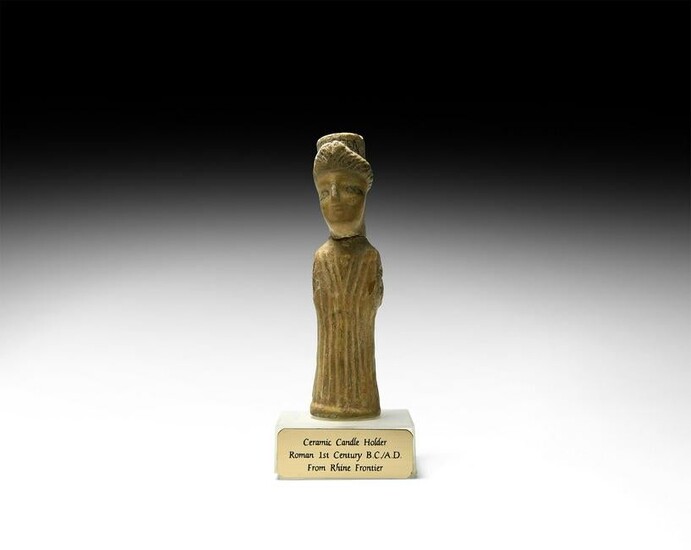Roman Painted Figural Candle Holder
1st century BC-1st century AD. A pottery candle holder shaped as a woman, dressed with a long tunica talaris decorated with vertical lines, on the head the hair arranged in a high propoloma surmounted by the candle insertion hole, traces of colour visible on the body, around the eyes and on the hair. See Brinkmann, V., Wünsche R. (eds.), Bunte Götter. Die Farbigkeit antiker Skulptur. Staatliche Antikensammlungen und Glyptothek, Munich, 2004. 66 grams total, 14cm including stand (5 1/2"). From the private collection of Antony John Scammell (1937-2019); acquired on the UK art market from 1960-2000. Large and small sculptures in the ancient world were painted with vivid colours. Most ancient pigments were derived from minerals, some of which were toxic (natural cinnabar, the most popular red colour in the ancient world, for example, came from mercury"). To make paint, the pigments were mixed with binders made from common items such as eggs, beeswax and Arabic gum. Antony John Scammell (1937-2019) was born, and lived his entire life, in the city of Bristol, England. Already from an early age he was enthralled by history and the heroes that it created. While serving overseas with the British Army, Antony began collecting coins and banknotes and this led to collecting a variety of different items throughout his life. From the early 1960s onward, Antony invested in acquiring ancient artefacts. Antony's vast collections started with Egyptian antiquities, but soon branched into Greek and Roman civilisations. The Roman civilisation fascinated him most and, when family commitments allowed, archaeological digs were coordinated in the west of England. These digs uncovered numerous artefacts, many of which were donated to local museums. In retirement, the collecting continued apace, branching into UK coins, British Empire banknotes and fossils. [No Reserve]
Condition Report: Fine condition, repaired.
Sale price
Estimate
Time, Location
Auction House
1st century BC-1st century AD. A pottery candle holder shaped as a woman, dressed with a long tunica talaris decorated with vertical lines, on the head the hair arranged in a high propoloma surmounted by the candle insertion hole, traces of colour visible on the body, around the eyes and on the hair. See Brinkmann, V., Wünsche R. (eds.), Bunte Götter. Die Farbigkeit antiker Skulptur. Staatliche Antikensammlungen und Glyptothek, Munich, 2004. 66 grams total, 14cm including stand (5 1/2"). From the private collection of Antony John Scammell (1937-2019); acquired on the UK art market from 1960-2000. Large and small sculptures in the ancient world were painted with vivid colours. Most ancient pigments were derived from minerals, some of which were toxic (natural cinnabar, the most popular red colour in the ancient world, for example, came from mercury"). To make paint, the pigments were mixed with binders made from common items such as eggs, beeswax and Arabic gum. Antony John Scammell (1937-2019) was born, and lived his entire life, in the city of Bristol, England. Already from an early age he was enthralled by history and the heroes that it created. While serving overseas with the British Army, Antony began collecting coins and banknotes and this led to collecting a variety of different items throughout his life. From the early 1960s onward, Antony invested in acquiring ancient artefacts. Antony's vast collections started with Egyptian antiquities, but soon branched into Greek and Roman civilisations. The Roman civilisation fascinated him most and, when family commitments allowed, archaeological digs were coordinated in the west of England. These digs uncovered numerous artefacts, many of which were donated to local museums. In retirement, the collecting continued apace, branching into UK coins, British Empire banknotes and fossils. [No Reserve]
Condition Report: Fine condition, repaired.



